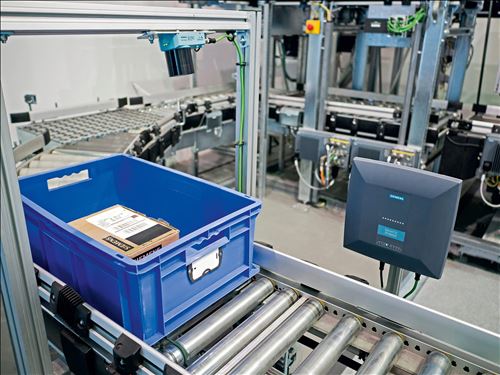 Sendtime 2020-01-19
Sendtime 2020-01-19 BY
BY  Read 849
Read 849RFID (radio frequency identification) is a kind of non-contact automatic identification technology.Short-range rfid requires no manual intervention and is not afraid of oil stains, dust pollution and other harsh environments. It can replace the bar code in such environments, such as the application of tracking objects on the assembly line of factories.

I. specific application of production line management based on RFlD
In order to produce better quality products and reduce production costs.And to meet the requirements of ISO 9000, manufacturers are more carefully tracking product information and lJ processes, which require manufacturers to implement RFID.
RFID is entering the heart of the manufacturing process.Through the workshop layer gradually using RFID technology in the factory, manufacturers can directly and continuously to obtain information from RFID capture and link to the existing, verified and industry to strengthen the control system of infrastructure, and configuration of RFID function of the supply chain coordination, which do not need to update the existing manufacturing execution system (MES) and manufacturing information system (MIS), you can send accurate, reliable and real-time information flow, so as to create value, increase productivity and greatly save investment.

Ii. Processing of real-time effectiveness of information management
For manufacturers, timely and accurate feedback information from the production line is very important. In the past, such information could only be calculated after the end of production.
If RFID readers are installed at each node of the production line, and RFID electronic tags that can be read and written repeatedly are placed on the product or tray.In this way, when these products or pallets pass through these nodes, the RFID read-write device can read the information in the labels on the products or pallets, and feed these systems back to the background management system in real time, so that the manufacturer can easily keep track of the detailed working conditions of the production line.And by combining RFID with existing manufacturing information systems such as MES, ERP, CRM and IDM, a stronger information chain can be built to deliver accurate data at the right time, thus enhancing productivity, asset utilization and quality control at a higher level.

Iii. Application in manufacturing management process
Because RFID provides a constantly updated stream of real-time data, combined with manufacturing execution systems, this information can be used to ensure the proper use of labor, machinery, tools, and components.With this timely and accurate information management, paperless, contract production is possible, and can greatly reduce the production line downtime, improve production efficiency.
If there is a batch or even several batches of contract products, it is necessary to use the same production line to add T production, but only in some parts are slightly different.In the past, the production method can only use the first production of the same model of products, the production line will stop, after the adjustment of the production of another model of products, so caused the loss.
Through the implementation of RFID system, different types of products can be coded and written into the RFID electronic tags.When the products of different models enter the processing point, the RFID read-write device reads the information in the RFID active electronic tag, so that the processing equipment can confirm which type of products to process.If there is an automatic classification transmitter, through the identification of RFID tags, it can be easily complete the classification of products, so as to send the product to the correct production line.

Iv. Application of RFID technology in production logistics management
Manufacturing involves both procurement and sales as well as the manufacture of low-value materials that are converted into higher-value products.Quick Response and Agility are key factors for the success of manufacturing.And production logistics is the core link of the whole logistics of manufacturing industry.Production logistics and production process synchronization, from the purchase of raw materials to the delivery of finished products until the whole process of logistics activities.Raw materials, semi-finished products and so on according to the process flow in each processing point without stopping to move, transfer, the formation of production logistics.It is a unique activity of the manufacturing enterprise that makes the product, and if production is interrupted, so is the logistics of production, and vice versa.
With the help of RFID technology, electronic tags on raw materials, components, semi-finished products and work-in-process products enable production plan managers to quickly locate and understand the consumption of raw materials. This will greatly improve the efficiency and quality of production;At the same time, RFID technology can also be used to collect and process product information, to help the production staff easily grasp the operation of the entire production line and to accelerate the production schedule.Due to its read-write nature, RFID provides a stream of constantly updated real-time data.Complementary to manufacturing execution systems, RFID provides information that can be used to ensure the correct use of labor, machinery, tools, and components.So as to realize paperless production and reduce downtime, and promote the smooth progress of production logistics.
RFID production line management scheme
Furthermore, by combining RFID with existing manufacturing information systems such as ERP and CRM, a stronger information chain can be established and accurate data can be delivered in a timely manner at an accurate time, thus improving asset utilization, enhancing productivity, conducting various online measurements and supporting quality control.

V. Accurate information tracking
Compliance with FDA quality standards will enable manufacturers of consumer packaging, food and beverage products to accurately track and trace product information throughout their supply chains.Nowadays, due to the negligence of some link, the products with quality problems enter the market.These quality problems, the most serious may lead to the consumer's life is threatened.Therefore, the news that the manufacturer recalled the product is not uncommon.With the help of RFID system, accurate and timely information feedback enables manufacturers to quickly query the production date, contract number, source of raw materials, production process, and even to the precise information of a problem product as required.In manufacturing products (tray) recognition, intelligent conveyor path selection, date and time verification, automatic guided vehicle, batch production formula and so on each link, the application of RFID system, can achieve real-time information management, flexible management, the accurate tracking and trace these goals, and improve the level of automated production, the production efficiency, make management more flexible, eventually benefit manufacturers.

Vi. The application of RFID technology in large manufacturing enterprises will bring huge profit prospects.
But along with the huge benefits, there will also be huge challenges in implementing the new technology.Therefore, for large manufacturing enterprises, before the implementation of RFID technology, we must do a good job in the early planning, for the future successful implementation of RFID system to lay a solid foundation.
1. Cost/benefit analysis.
A cost/benefit analysis is critical to the success of RFID.At present, there are still some problems in the implementation of RFID technology, such as cost, technology and standards.But RFID technology can bring huge benefits, including indirect ones, such as improved customer satisfaction.These should be included in the report, and according to the actual situation of investment income analysis.
2. Application system analysis.
Prior to implementation, business requirements for deploying RFID systems are identified and analyzed.At the same time, we should fully consider the various factors in the development and deployment of RFID system.Once it's done, put it in the hands of the people who really have the say, to make sure they're actually implemented.
3. Make the implementation plan.
Develop RFID implementation plan based on analysis report of application system.RFID project implementation, generally divided into four feasible phase of the plan, gradually achieve a smooth and slow transition.Namely: start, test and verification, pilot implementation and real implementation of the four stages.For large manufacturing enterprises, the key lies in how to use RFID information to integrate with the existing system of the enterprise, optimize the internal business process and improve the core competitiveness of the enterprise.Although the real implementation of RFID is not easy, it sometimes requires the reorganization of existing production lines, high-quality staff training, regular inspection of software systems and hardware equipment, and so on.However, the application of RFID technology will bring great benefits to the enterprises with modern enterprise management awareness.

 Relate recommen
Relate recommen

Tel:010-84048366
Email:gracewitark@gmail.com 
Add:shenzhou-great wall building, no.2 yard, shimen middle road, chaoyang district, Beijing
Scan watching us